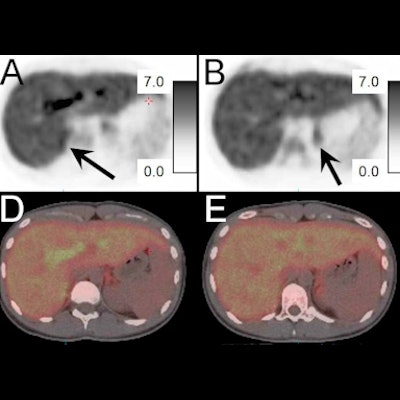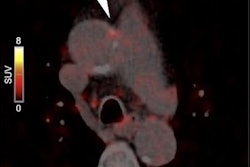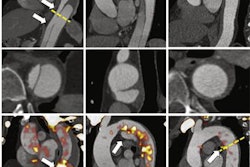
A new PET radiotracer is safe for humans and could provide a noninvasive approach for diagnosing aldosteronism, a condition linked to high cholesterol and heart disease, according to a study published April 28 in the Journal of Nuclear Medicine.
Researchers at the University of Michigan in Ann Arbor synthesized a fluorine-18 (F-18) tracer combined with a ligand that reveals abnormal hormone activity (aldosteronism) related to cholesterol uptake in the adrenal glands. Early results suggest the tracer could replace invasive blood tests in patients prior to hormone therapy, the authors wrote.
"With FNP-59 development we could now explore if this agent can identify the cause of primary aldosteronism," wrote corresponding author Dr. Benjamin Viglianti, PhD, a clinical associate professor of radiology.
Primary aldosteronism occurs when adrenal glands are triggered by cholesterol to produce too much aldosterone, the hormone responsible for balancing potassium and sodium in the body. Overproduction of aldosterone causes the body to retain more sodium and lose potassium, which leads to elevated blood pressure. Patients with this condition are at increased risk of heart disease and stroke.
By imaging cholesterol uptake in the adrenal glands, clinicians may be able to develop therapies to prevent this potentially deadly chain of events.
University of Michigan researchers first developed a radiotracer for this type of imaging (NP-59) in 1975, but the tracer was based on an iodine-131 (I-131) radioisotope that limited its use due to high radiation doses, according to Vigilianti, who discussed the process of synthesizing the new tracer at RSNA 2021 in November 2021.
The researchers leveraged advances in radiochemistry techniques to develop FNP-59. Specifically, they used a recently developed mild fluorinating reagent in the process that allows F-18 to bind to NP-59 during chemical synthesis.
The researchers tested FNP-59 versus its I-131 precursor in animal studies in New Zealand rabbits and demonstrated the radiotracer performed equally as well and had no adverse effects at a dose 1,000 times greater than that used in a typical PET/CT imaging study.
They subsequently moved forward and have tested FNP-59 in four patients, with first-in-human imaging now published.
Two healthy men and two healthy women underwent FNP-59 PET/CT imaging three hours after a tracer injection of 6 millicuries. In all subjects, there was intense tracer uptake in the liver and gallbladder, similar to the rabbit experiments, as well as uptake of the tracer in adrenal glands.
 PET/CT images of FNP-59 in a 21-year-old female without adrenal pathology and pretreated with cosyntropin given prior to 6 mCi of F-18 FNP-59. Axial PET images obtained three hours after injection of the upper abdomen with adrenal glands (black arrows) identified on the right (A) and left (B). Scale bars are 0-7 SUV. Adrenal-to-liver ratio at ~1.3:1 on the right and 1:1.1 on the left at three hours. Fused PET/CT images of the adrenal glands are also shown (D, E) along with maximum intensity pixel image (C) that demonstrates expected gallbladder/biliary/bowel uptake given bile secretion. Image courtesy of the Journal of Nuclear Medicine.
PET/CT images of FNP-59 in a 21-year-old female without adrenal pathology and pretreated with cosyntropin given prior to 6 mCi of F-18 FNP-59. Axial PET images obtained three hours after injection of the upper abdomen with adrenal glands (black arrows) identified on the right (A) and left (B). Scale bars are 0-7 SUV. Adrenal-to-liver ratio at ~1.3:1 on the right and 1:1.1 on the left at three hours. Fused PET/CT images of the adrenal glands are also shown (D, E) along with maximum intensity pixel image (C) that demonstrates expected gallbladder/biliary/bowel uptake given bile secretion. Image courtesy of the Journal of Nuclear Medicine.Three of the subjects were pretreated with cosyntropin prior to FNP-59 injection to stimulate adrenal gland cholesterol activity, which resulted in a more than doubling of F-18 FNP-59 uptake at one and three hours, along with increased uptake during dynamic phase imaging, according to the findings.
No adverse events were observed in subjects after F-18 FNP-59 injection or within the following days.
"Overall this work demonstrates the initial feasibility of F-18 FNP-59 to image cholesterol trafficking and specifically uptake in human cortical adrenal tissue," the researchers stated.
The data needs to be replicated in other normal subjects stimulated with cosyntropin and imaged at later time points and, more importantly, in patients diagnosed with aldosteronism treated with and without hormone suppression therapy, they added.
"We plan to study patients that have been diagnosed with primary aldosteronism and will receive adrenal vein sampling to determine if imaging by PET/CT using F-18 FNP-59 can lateralize disease," Viglianti and colleagues concluded.



















